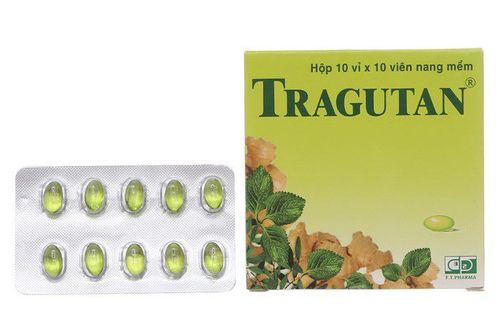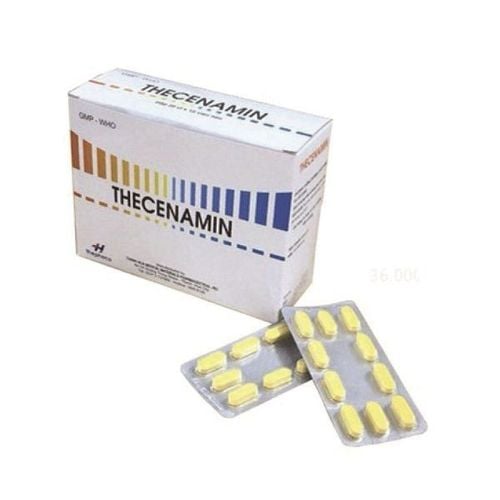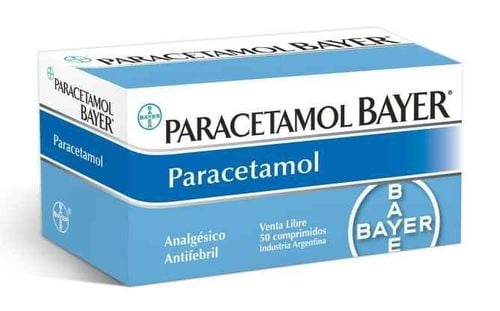This is an automatically translated article.
Tacodolgen contains two main ingredients: Paracetamol and Chlorpheniramine. Tacodolgen is indicated in the symptomatic treatment of flu cases such as fever, headache, muscle pain, joint pain accompanied by runny nose, allergic rhinitis, urticaria, itching. The following article provides you with information about the uses and doses of Tacodolgen.1. What are the effects of Tacodolgen?
Tacodolgen has two main active ingredients: Paracetamol with the content of 325mg and Chlorpheniramine with the content of 2mg. Tacodolgen is available in the form of tablets.Paracetamol is an active metabolite of phenacetin, an effective analgesic and antipyretic that can replace Aspirin, but Paracetamol has no effect on inflammation. Paracetamol acts on the hypothalamus to cause hypothermia, increase thermogenesis, increase vasodilation, and increase peripheral blood flow. When overdose of Paracetamol, the drug's metabolite is N-acetyl-benzoquinoneimin can cause hepatotoxicity.
Chlorpheniramine is an antihistamine. Like other antihistamines, chlorpheniramine has anticholinergic effects, but this effect varies from person to person. Chlorpheniramine's antihistamine effect is through a mechanism of competitive blockade of H1 receptors of effector cells.
2. Indications and contraindications of Tacodolgen
Indications Tacodolgen is indicated in the symptomatic treatment of flu cases such as fever, headache, muscle pain, joint pain accompanied by runny nose, allergic rhinitis, urticaria, itching.Contraindications: Tacodolgen is contraindicated in the following cases: Allergy or hypersensitivity to Paracetamol, Chlorpheniramine or any excipients of Tacodolgen. Patients with glucose-6-phosphate dehydrogenase deficiency. The patient is having an acute asthma attack. There are symptoms of an enlarged prostate gland. Angle-closure glaucoma, bladder neck obstruction, gastric ulcer, pyloric stenosis. Women who are breastfeeding. Pregnant women in the last 3 months of pregnancy. Newborns, premature babies. The patient received a monoamine oxidase inhibitor within 1 day of treatment with chlorpheniramine because the anticholinergic properties of Chlorpheniramine are enhanced by the MAO inhibitor.
3. How to take Tacodolgen
3.1. Dosage
Tacodolgen is taken orally, under the guidance of a doctor. Dosage of Tacodolgen:Adults: 1-2 tablets/time x 2-3 times/day. Children 7 - 15 years old: 1⁄2 - 1 tablet / time x 2 - 3 times / day. Tacodolgen should not be used for more than 10 days in adults or more than 5 days in children, unless under the direction of a physician.
3.2. Tacodolgen overdose and treatment
Related to Paracetamol Symptoms of Paracetamol Overdose: Paracetamol toxicity can be caused by taking a single toxic dose or taking large doses of Paracetamol multiple times (eg: 7.5 - 10g per day, taken for 1-2 days) or due to long-term use of Paracetamol. Dose-dependent hepatic necrosis is the most serious acute toxic effect of paracetamol overdose and can be fatal. Abdominal pain, nausea, and vomiting usually occur within 2 to 3 hours of taking a toxic dose of Paracetamol. Methemoglobinemia may occur, resulting in cyanosis of the skin, mucous membranes, and nails.Treatment of overdose Paracetamol: Gastric lavage in all cases, preferably within 4 hours after taking the drug. The main detoxification therapy is the use of Sulfhydryl compounds, N-acetylcysteine and activated charcoal.
Related to Chlorpheniramine The fatal dose of Chlorpheniramine is about 25 - 50 mg/kg body weight.
Symptoms of Chlorpheniramine overdose include sedation, paradoxical central nervous system stimulation, seizures, psychosis, convulsions, apnea, anticholinergic effects, dystonic reactions and cardiovascular collapse , arrhythmia.
Management of overdosage of Chlorpheniramine: Treatment of symptoms and support of vital functions. Particular attention should be paid to the patient's liver, kidney, heart, respiratory and water and electrolyte balance.
3.3. Missing a dose of Tacodolgen and deal with it
If you forget to take a dose of Tacodolgen, take it as soon as possible. However, if it is almost time for your next dose of Tacodolgen, skip the missed dose and take your next dose at the scheduled time. Do not take double the prescribed dose.4. Undesirable effects when using Tacodolgen
4.1. Related to Paracetamol
Several other allergic reactions may occur. Common erythema, urticaria, sometimes more severe and may be accompanied by drug fever and mucosal lesions. Patients sensitive to salicylates are rarely sensitive to Paracetamol and related drugs. In isolated cases, Paracetamol may cause pancytopenia, thrombocytopenia and neutropenia. Uncommon: Rash, nausea, vomiting, hematopoietic system disorders, anemia, nephropathy and nephrotoxicity with long-term use. Rare: Hypersensitivity reactions to the drug.4.2. Regarding the drug Chlorpheniramine
Use of Chlorpheniramine may occur undesirable effects such as: Sedative effects vary widely from light drowsiness to deep sleep, dry mouth, dizziness and irritability, this symptom usually occurs when treatment is interrupted. interval. However, most patients tolerate side effects with continued treatment, especially if the dose of chlorpheniramine is increased gradually. Common: Somnolence, sedation, dry mouth. Rare: Nausea, dizziness. The adverse effects of anticholinergics on the central nervous system and anticholinergic effects in susceptible individuals (those with glaucoma, prostatic hypertrophy and other susceptible conditions) can be serious.5. Some notes when using Tacodolgen
Related to Paracetamol Use caution when using Paracetamol in people with kidney failure, liver failure, phenylketonuria.Drinking a lot of alcohol can increase the hepatotoxicity of Paracetamol, so limit or avoid alcohol while using the drug.
Patients should be warned about symptoms of serious skin reactions such as Stevens-Johnson syndrome, Lyell's syndrome, and acute generalized exanthematous pustulosis.
Related to Chlorpheniramine Chlorpheniramine may increase the risk of urinary retention due to the anti-acetylcholine side effect of the drug, especially in patients with urinary tract obstruction, prostate enlargement. Chlorpheniramine may be aggravated in patients with myasthenia gravis.
The sedative effect of Chlorpheniramine is increased with alcohol consumption, concomitant use with other sedatives.
There is a risk of respiratory complications, respiratory failure and apnea, which can be problematic in young children or patients with chronic obstructive pulmonary disease. Chlorpheniramine should be used with caution in patients with chronic lung disease, shortness of breath, or difficulty breathing.
Risk of tooth decay in patients on long-term chlorpheniramine treatment, due to the anti-acetylcholine effect causing dry mouth.
Avoid using Chlorpheniramine in patients with glaucoma, who drive or operate machinery.
Use caution in people > 60 years of age because of increased sensitivity to anticholinergic effects.
Pregnant women Tacodolgen should be used in pregnant women only when clearly needed. Tacodolgen should not be used during the last 3 months of pregnancy.
Lactating women Chlorpheniramine may be excreted in breast milk and inhibit lactation. Antihistamines can cause serious reactions in nursing infants, so depending on the need for the drug to the mother, consider either not breastfeeding or not taking Tacodolgen.
6. Drug interactions
Coumarin, indandion derivative: Long-term administration of high doses of Paracetamol may slightly increase the anticoagulant effect of the drug. Attention should be paid to the potential for severe hypothermia in patients receiving concomitant phenothiazines and antipyretic therapy. Drinking alcohol increases the risk of Paracetamol's hepatotoxicity. Anticonvulsants (including phenytoin, carbamazepine, barbiturates) induce enzymes in the liver microsomes, may increase the hepatotoxicity of Paracetamol. Isoniazid and anti-tuberculosis drugs: Concomitant use increases the toxicity of Paracetamol to with liver. Monoamine oxidase inhibitors: prolong and potentiate the anticholinergic effect of antihistamines. Ethand, hypnotic sedative: Concomitant use may increase the CNS depressant effect of Chlorpheniramine. Chlorpheniramine inhibits the metabolism of phenytoin and may lead to phenytoin toxicity.Please dial HOTLINE for more information or register for an appointment HERE. Download MyVinmec app to make appointments faster and to manage your bookings easily.













